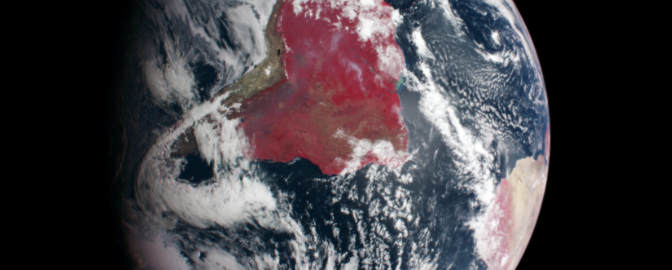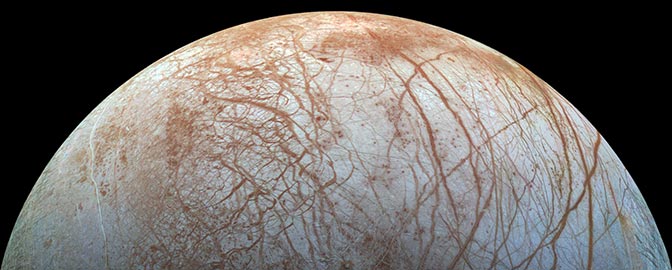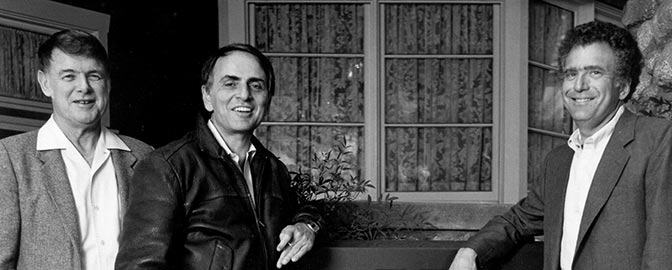The Voyager Golden Records: A cosmic love letter

Written by
Kate Howells
Public Education Specialist, The Planetary Society
April 29, 2025
On my left shoulder, I have a tattoo of the Voyager spacecraft.
NASA’s twin Voyagers explored the outer Solar System throughout the late twentieth century, taking advantage of a planetary alignment to collectively fly by all four outer planets. They are now the most distant human-made objects, billions of miles from home and counting. Amazingly, 47 years after launching, both spacecraft are still collecting and transmitting data back to Earth. But those achievements aren’t why I love the Voyager program so much.
Voyager holds a special place in my heart — and on my skin — because of the Golden Records.

A little about Voyager
The Voyagers launched in 1977 on a dual-spacecraft mission to learn more about the outer planets.
As they passed Jupiter and Saturn, Voyager 1 and 2 both studied the gas giants and opened our eyes to the beautiful, astonishingly diverse moons in those systems. Voyager 2 got to do even more, with a path that took it past Uranus and Neptune as well, seeing these worlds up close for the first time (and, to this day, the only time).
After completing their primary missions, both spacecraft kept going. As I write, they’re still sending data back to Earth as they zoom away from the Sun at a blistering 17 kilometers per second (more than 10 miles per second, a.k.a. faster than your brain can comprehend).
And Voyager 1 and 2 are just going to keep on zooming — maybe even for millions of years, if nothing gets in their way.
Even though space is mind-bogglingly empty, it’s possible that either spacecraft could collide with a planet, a star, or maybe even a black hole. Or — the really juicy possibility — they could be intercepted by another space-exploring civilization. This is where the Golden Records come in.
A little about Earth, and us
Previous spacecraft, including NASA’s twin Pioneer probes, have included information displays just in case they were intercepted by intelligent aliens. This possibility might seem far-fetched, but it’s not impossible. And if there’s even the slimmest chance of some far-off alien discovering a human artifact, it’s worth it to attach a note.

The Voyager mission took Pioneer’s effort to communicate with aliens to the next level. Each Voyager spacecraft carries with it a 12-inch, long-playing phonograph record (what you might call an LP) encoded with sounds and images from Earth. (Because why just attach a note when you can include a selfie and your personal anthem?)
The team chose a phonograph record not just because they were all the rage in the 1970s — they weren’t trying to be cool. The idea actually came from astrophysicist Frank Drake, PhD, who famously created an equation for determining the likelihood of intelligent alien life in our Universe.
Drake pointed out that because sound information in a record is physically etched into grooves, if the right material were used, that information could last for a very long time — maybe even millions of years. The Voyager Golden Records are made of gold-plated copper, and each is encased in an aluminum cover — materials that should be able to endure the harsh conditions of space.
Instructions for playing the record are etched on the cover. Planetary scientist Jim Bell, PhD, who worked on the Voyager program and now serves on The Planetary Society’s board of directors, joked in his book “The Interstellar Age” that modern youths would probably need just as detailed instructions as the aliens would to learn how to play a record.
The instructions chosen for the hypothetical aliens are pretty different from what you’d show a modern teen. They’re written in a kind of code based on mathematics that any advanced alien species should be able to decipher. (Maybe a truly advanced teen would get it too, to be fair.) A cartridge and stylus — the mechanisms needed to play a record — are also included nearby, and illustrated on the cover.

The Golden Record’s purpose was to communicate something about humans beyond our technological capabilities, which would have been understood just by examining the spacecraft itself. Its message aimed to showcase Earth, life, humanity, and, maybe above all else, emotion. To achieve this, the records contain the sights and sounds of our planet, including what might be considered the most important mixtape of all time.
What would you put on a mixtape for aliens?
The team behind the Voyager Golden Records had a monumental task, to be sure.
On one side of each record, they selected a variety of sounds we associate with daily life and nature. There’s wind, rain, ocean surf, a chimpanzee, crickets, frogs, birds, whale songs, footsteps, heartbeats, laughter, a kiss on the cheek, and short greetings in fifty-five languages — plus a super-cute hello from a five-year-old kid.
Ann Druyan, a science communicator tasked with compiling sounds for the record, even recorded her own brain waves via an electroencephalogram.
That same side of each record also contains music. Carl Sagan, PhD — a famed astronomer, science communicator, leader of the Voyager Golden Record project, co-founder of The Planetary Society, and one of my personal heroes — was particularly excited about what it meant to share music with an alien being.
In the book “Murmurs of Earth,” which chronicles the project, Sagan wrote about how previous messages sent from Earth into the Cosmos, like the Pioneer plaques, had conveyed what humans perceive and how we think. “But there is much more to human beings than perceiving and thinking,” Sagan wrote. “We are feeling creatures. However, our emotional life is more difficult to communicate, particularly to beings of very different biological makeup. Music, it seemed to me, was at least a creditable attempt to convey human emotions.”
Sagan, like any of us who’s been through a breakup, knew how powerful music can be at capturing how we feel. But he didn’t want to just compile his favorite songs.
Instead, he worked with ethnomusicologists and historians to put together a collection of music as representative as possible of the geographical, ethnic, and cultural diversity of Earth’s musical cultures. This wound up ranging from a Beethoven symphony to Peruvian panpipes, an Indian raga to Louis Armstrong.
As Planetary Society CEO Bill Nye will tell you anytime he gets the chance, he (a student of Sagan’s at the time) petitioned to include Chuck Berry’s “Johnny B. Goode” as well. The aliens had to know we were cool, after all.
Pictures worth thousands of words
On the other side of each Golden Record, image data is encoded into the grooves. As someone who’s only ever encountered records that play sound, I thought this was pretty neat. The way they did it was by breaking up each image into pixels and then mapping each pixel’s brightness to the frequency of the vibrations in the record needle — a code explained in the instructions on the record cover.
Any intelligent being that figured that all out would be rewarded with a wealth of imagery about our world. The guiding principle behind the image selections was to be informative, not aesthetic. It’s more like a postcard than an art book. It had 116 photos of neighboring planets, landscapes, animals, plants, dwellings and other buildings, vehicles, a sunset, and, of course, people in action.

All about love
The overarching theme that ties all of the Voyager Golden Record content together is emotion. More specifically, it’s love.
When you make a mixtape (or, in this day and age, a playlist) for your crush, it’s a loving gesture. I’d argue that the same could be said of thinking of aliens who might be out there and sending them the most carefully thought-out mixtape of all time.
In a world where people can be fearful of outsiders and strangers, the Voyager Golden Records are an especially warm and welcoming gesture. They’re a warm welcome to an unknown civilization, trustingly introducing ourselves and providing a map for them to find us.
The Golden Records also show humanity in a fundamentally loving way. The records’ curators intentionally avoided depictions of war, disease, crime, and poverty. These are real aspects of humanity, and when you turn on the news they’re the ones you’re confronted with the most. But Sagan and his team felt that they didn’t truly represent who we are as a species.
With the Voyager Golden Records, we are showing off the things we are most proud of, the things that we love most about Earth and its inhabitants.
And if that weren’t poetic enough, Ann Druyan and Carl Sagan also happened to fall in love with each other while working on the Golden Record project. In a 2010 interview with the podcast Radiolab, Druyan talked about how her feelings for Sagan made their way onto the Golden Records. That recording of her brainwaves? Turns out she was thinking, in part, about Sagan.
“This was two days after Carl and I declared our love for each other,” she said in the interview. “And so… part of what I was thinking in this meditation was about the wonder of love and of being in love.”
Ann Druyan Celebrates Voyager's 35th Anniversary Carl Sagan's collaborator and wife, Ann Druyan, recorded this eloquent and passionate greeting for the Planetary Society's celebration of the Voyager mission. Ann served as Creative Director for the creation of the Golden Record carried by both Voyager spacecraft.
Through and through, the Voyager Golden Records were a love letter to the Cosmos, to ourselves, and to our planet.
B.M. Oliver, an advisor to the project, is quoted in “Murmurs of Earth” pointing out that “there is only an infinitesimal chance that the plaque will ever be seen by a single extraterrestrial, but it will certainly be seen by billions of terrestrials. Its real function, therefore, is to appeal to and expand the human spirit...”
So while yes, the Golden Records were crafted with hypothetical aliens in mind, the contents of the Voyager Golden Records ultimately hold a mirror up to Earth, showing us ourselves in the most loving, positive light. And, to this day, you’re welcome to take a look at that reflection — it’s as simple as visiting NASA’s website.
An eternal legacy
The Voyager mission team didn’t have to make this loving gesture to the Cosmos. It contributed nothing to the mission's scientific goals, took extra work and budget, and wasn’t practical or pragmatic at all.
But the same could be said about other great, beautiful public works — Grand Central Terminal in New York didn’t need to be an architectural marvel with a sky-painted ceiling and chandeliers, but it is. It was designed to be beautiful, a gesture of love for the people who pass through it.
In the decades since the Voyagers launched, other mission teams have taken the time to craft messages to send along with spacecraft, carrying on the Golden Records’ spirit of optimism, reflection, and love.
One of the most enduring may be NASA’s Lucy mission, which launched in 2021 on its way to the Jupiter Trojan asteroids and will end up circling the Sun for millions of years. It carries a plaque with quotes from prominent thinkers of our time, including several reflections on love.
Among them, a lyric by Paul McCartney: “And in the end, the love you take is equal to the love you make.”
Today, missions of exploration as ambitious and visionary as Voyager are, unfortunately, exceedingly rare. Great public projects like this can only happen if the public supports them. In times of austerity, more than ever, it’s vital to speak up if you believe that exploration is worth the investment.
It’s like what Paul McCartney said about love: we get out what we put in.
And the Voyager Golden Records are a great example of just how much a little extra investment can give us. Thanks to the love and care of the handful of people who conceived of and compiled this message in a bottle, some piece of humanity will carry on long after we’re all gone.
Even if that message in a bottle is never intercepted, the Voyager Golden Records have made the human species, our planet, and our love immortal in the Universe.
That’s a beautiful gift to you, to me, and to all of humanity.
And if that’s not worthy of a tattoo, I don’t know what is.
Breakthrough research starts with YOU!
Your support will empower the next round of STEP grant winners. Make your gift today to fund tomorrow's promising science and technology projects.
Donate

 Explore Worlds
Explore Worlds Find Life
Find Life Defend Earth
Defend Earth

